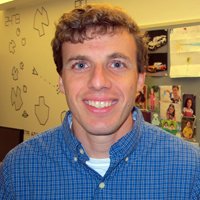Andrew Ruether '94 Key to Why Swarthmore Exemplifies Use of Supercomputing Resources
Andrew Ruether '94 Key to Why Swarthmore
Exemplifies Use of Supercomputing Resources
by Alisa Giardielli
1/11/12

In response to faculty and student interest in large-scale computational modeling and calculations, Academic Technologist Andrew Ruether '94 looked for a way to make high performance computing available on campus. His search led him to what is now known as the Extreme Science and Engineering Discovery Environment (XSEDE), an NSF-funded project that is described as "the world's most advanced, powerful, and robust collection of integrated digital resources and services."
Swarthmore joined XSEDE's Campus Champions program in Fall 2010, with Ruether in the titular liaison role. His success in that role is featured in XSEDE's 2011 annual report as an example of how dedicated "champions" broaden the project's reach.
Specifically, Ruether is cited for helping:
- students in Associate Professor of Computer Science Tia Newhall's class on Distributed and Parallel Computing use supercomputers for class projects. Two students continued their work after the class ended and developed an algorithm that can be applied to a variety of tasks; their work was presented at a 2010 conference on building and using cyber infrastructure.
- Professor of Chemistry and Biochemistry Paul Rablen investigate rearrangements in highly reactive carbon molecules that are widely used as catalysts. This work was published last year by the Journal of Organic Chemistry.
- Professor of Physics Michael Brown, who is working on ways to design fusion reactors, and one of Brown's students, Dan Dandurand '11, who calculated the complex orbits of more than a billion energetic protons. Those calculations helped shed light on magnetic confinement fusion. In another set of calculations, he determined the fraction of energetic protons collected by a simulated probe in the plasma. These calculations helped to calibrate and understand a probe used in experiments. They published this research in the Review of Scientific Instruments last year.
Swarthmore is one of only a small number of liberal arts colleges currently in the consortium. "I have collaborated with staff members at places like the National Center for Supercomputing Applications at the University of Illinois, the Pittsburgh Supercomputing Center, and Purdue University in order to get projects completed," Ruether says. "It's fantastic that we can combine the richness of a Swarthmore education with the research computing infrastructure of a large university. In the future, I'd like to continue to expand my work in the sciences as well as find some faculty members in the social sciences and humanities that could take advantage of the computing power that we have available.
"I have definitely enjoyed working with my former professors," adds Ruether, who majored in physics. "Being an alum has made it much easier to understand how best to support faculty and students that are working on interesting projects. It brings back memories of my own experiences in the classroom and research labs at Swarthmore. "


